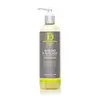What's inside
What's inside
 Key Ingredients
Key Ingredients

 Benefits
Benefits

 Concerns
Concerns

 Ingredients Side-by-side
Ingredients Side-by-side

Water
Skin ConditioningSodium C14-16 Olefin Sulfonate
CleansingCocamidopropyl Hydroxysultaine
CleansingPolyquaternium-7
Cocamide Mea
EmulsifyingAcrylamidopropyltrimonium Chloride/Acrylamide Copolymer
Phenoxyethanol
PreservativeBenzoic Acid
MaskingEthylhexylglycerin
Skin ConditioningGlycereth-2 Cocoate
EmulsifyingPropanediol
SolventGlycol Distearate
EmollientPrunus Amygdalus Dulcis Fruit Water
Skin ConditioningPersea Gratissima Fruit Extract
EmollientButyrospermum Parkii Leaf Extract
EmollientOlea Europaea Fruit Extract
BleachingSimmondsia Chinensis Seed Extract
AbrasiveTheobroma Cacao Extract
Skin ConditioningCocos Nucifera Fruit Extract
EmollientAleurites Moluccanus Seed Extract
Skin ConditioningParfum
MaskingBenzyl Benzoate
AntimicrobialCitral
PerfumingGeraniol
PerfumingLinalool
PerfumingLimonene
PerfumingWater, Sodium C14-16 Olefin Sulfonate, Cocamidopropyl Hydroxysultaine, Polyquaternium-7, Cocamide Mea, Acrylamidopropyltrimonium Chloride/Acrylamide Copolymer, Phenoxyethanol, Benzoic Acid, Ethylhexylglycerin, Glycereth-2 Cocoate, Propanediol, Glycol Distearate, Prunus Amygdalus Dulcis Fruit Water, Persea Gratissima Fruit Extract, Butyrospermum Parkii Leaf Extract, Olea Europaea Fruit Extract, Simmondsia Chinensis Seed Extract, Theobroma Cacao Extract, Cocos Nucifera Fruit Extract, Aleurites Moluccanus Seed Extract, Parfum, Benzyl Benzoate, Citral, Geraniol, Linalool, Limonene
Water
Skin ConditioningLauramidopropyl Betaine
CleansingSodium C14-16 Olefin Sulfonate
CleansingSodium Lauroyl Methylaminopropionate
CleansingGlycerin
HumectantCocamide Methyl Mea
Tea-Cocoyl Glutamate
CleansingParfum
MaskingPolyquaternium-10
Sodium Benzoate
MaskingCitric Acid
BufferingMyristyl Betaine
CleansingPPG-7
Skin ConditioningPhenoxyethanol
PreservativeDisodium EDTA
Polyquaternium-47
Skin ConditioningMenthol
MaskingEthylhexyl Methoxycinnamate
UV AbsorberDiethylamino Hydroxybenzoyl Hexyl Benzoate
UV FilterHoney
HumectantArginine
MaskingRosa Damascena Flower Water
MaskingArgania Spinosa Kernel Oil
EmollientShea Butter Glycereth-8 Esters
CleansingDiethyl Sebacate
EmollientButylene Glycol
HumectantGluconobacter/Honey Ferment Filtrate
Skin ConditioningHydrolyzed Keratin
HumectantHoney Extract
HumectantCI 19140
Cosmetic ColorantCoco-Glucoside
CleansingHydrolyzed Honey Protein
Skin ConditioningRoyal Jelly Extract
Skin ConditioningCI 17200
Cosmetic ColorantKeratin
Skin ConditioningPropolis Extract
Skin ConditioningGamma-Docosalactone
Skin ConditioningWater, Lauramidopropyl Betaine, Sodium C14-16 Olefin Sulfonate, Sodium Lauroyl Methylaminopropionate, Glycerin, Cocamide Methyl Mea, Tea-Cocoyl Glutamate, Parfum, Polyquaternium-10, Sodium Benzoate, Citric Acid, Myristyl Betaine, PPG-7, Phenoxyethanol, Disodium EDTA, Polyquaternium-47, Menthol, Ethylhexyl Methoxycinnamate, Diethylamino Hydroxybenzoyl Hexyl Benzoate, Honey, Arginine, Rosa Damascena Flower Water, Argania Spinosa Kernel Oil, Shea Butter Glycereth-8 Esters, Diethyl Sebacate, Butylene Glycol, Gluconobacter/Honey Ferment Filtrate, Hydrolyzed Keratin, Honey Extract, CI 19140, Coco-Glucoside, Hydrolyzed Honey Protein, Royal Jelly Extract, CI 17200, Keratin, Propolis Extract, Gamma-Docosalactone
 Reviews
Reviews

Ingredients Explained
These ingredients are found in both products.
Ingredients higher up in an ingredient list are typically present in a larger amount.
Parfum is a catch-all term for an ingredient or more that is used to give a scent to products.
Also called "fragrance", this ingredient can be a blend of hundreds of chemicals or plant oils. This means every product with "fragrance" or "parfum" in the ingredients list is a different mixture.
For instance, Habanolide is a proprietary trade name for a specific aroma chemical. When used as a fragrance ingredient in cosmetics, most aroma chemicals fall under the broad labeling category of “FRAGRANCE” or “PARFUM” according to EU and US regulations.
The term 'parfum' or 'fragrance' is not regulated in many countries. In many cases, it is up to the brand to define this term.
For instance, many brands choose to label themselves as "fragrance-free" because they are not using synthetic fragrances. However, their products may still contain ingredients such as essential oils that are considered a fragrance by INCI standards.
One example is Calendula flower extract. Calendula is an essential oil that still imparts a scent or 'fragrance'.
Depending on the blend, the ingredients in the mixture can cause allergies and sensitivities on the skin. Some ingredients that are known EU allergens include linalool and citronellol.
Parfum can also be used to mask or cover an unpleasant scent.
The bottom line is: not all fragrances/parfum/ingredients are created equally. If you are worried about fragrances, we recommend taking a closer look at an ingredient. And of course, we always recommend speaking with a professional.
Learn more about ParfumPhenoxyethanol is a preservative that has germicide, antimicrobial, and aromatic properties. Studies show that phenoxyethanol can prevent microbial growth. By itself, it has a scent that is similar to that of a rose.
It's often used in formulations along with Caprylyl Glycol to preserve the shelf life of products.
Sodium C14-16 Olefin Sulfonate is a cleansing agent made from a mixture of long chain sulfonate salts. It can also help produce foam.
This ingredient may be drying. We recommend speaking with a professional if you have concerns.
Water. It's the most common cosmetic ingredient of all. You'll usually see it at the top of ingredient lists, meaning that it makes up the largest part of the product.
So why is it so popular? Water most often acts as a solvent - this means that it helps dissolve other ingredients into the formulation.
You'll also recognize water as that liquid we all need to stay alive. If you see this, drink a glass of water. Stay hydrated!
Learn more about Water